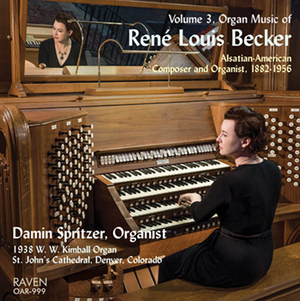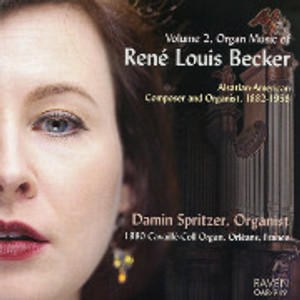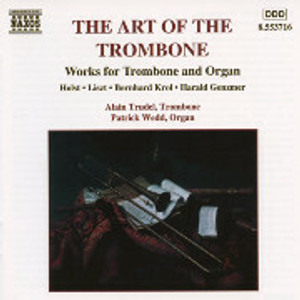|
Trombonist Donald Pinson and organist Damin Spritzer play interesting pieces for the combination with the grand Nichols & Simpson organ built in 2014 with four manuals and 71 ranks for Saint Monica Roman Catholic Church in Dallas.
Alan Hovhaness: Andante Religioso; Adagio from Symphony No. 29, op. 289
Paul Véronge de la Nux: Concert Piece
Gilles Senon: Prière
Frigyes Hidas: Fantasia
Frigyes Hidas: Domine, Dona Nobis Pacem
Max Glauser: Toccata from Trilogie
J. S. Bach: Aus tiefer Not schrei ich zu dir, BWV 686
Ernst Schiffmann: Intermezzo, op.53
Leopold Mozart: Adagio from Serenata in D for Orchestra
Johann Immanuel Müller: Praeludium, Chorale, Variations, and Fugue
Notes on the Music by Donald Pinson
The association of the trombone with liturgical music dates back longer than 400 years, yet this pairing of the solo trombone with the organ, long-standing centerpiece of church music, remains a bit of an anomaly. With its vocal quality and wide dynamic range, however, the trombone makes an ideal partner for the “king of wind instruments.” In the tradition of the free-form musical fantasia, we present to you this collection of our favorite compositions for trombone and organ, demonstrating the wide-ranging musical possibilities of these two instruments, and showcasing a variety of colors possible with the newly installed Nichols & Simpson organ.
Alan Hovhaness (1911-2000) was commissioned by Henry Charles Smith and C. G. Conn, Ltd., in 1976 to compose Symphony No. 29 in recognition of the 50th anniversary of the National Music Camp at Interlochen. This four-movement work for orchestra features a baritone horn soloist throughout, and the opening two movements transcribe beautifully for trombone and organ. Hovhaness’ fascination with world religions is reflected in the symphony’s opening Andante Religioso. One can hear, perhaps, in the rising and falling gestures of the trombone, prayers of supplication, answered in turn by the organ with grand chorale passages. An intervening contrapuntal passage places the trombone and organ in counterpoint, perhaps as a nod to the sacred musical traditions of the past, and the two instruments resume their “conversation” to conclude the movement.
The second movement Adagio, on the other hand, has a much lighter texture, with a sweet, understated melody in F major, performed in the more mellow middle register of the trombone. As a standalone work, this brief, two-and-a-half-minute movement would also serve well as incidental music for a church service or other occasion.
French composer Paul Véronge de la Nux (1853-1928) was known primarily for a few successful operas in the late 19th century, and for earning second prize in the 1876 Prix de Rome. He also composed a number of chamber works, including the Concert Piece for trombone and piano, written for the Paris Conservatory’s Concours de Prix in 1900. The work opens with a beautiful flowing melody in D minor. After a brief trombone cadenza, an exciting allegro places the trombone and keyboard in counterpoint, and this is followed by a chorale, taken up first by the trombone and then by the keyboard, accompanied by fast triplet passages in the trombone. The work concludes in G with a return of the opening four-note motive. Performed on organ, this work takes on a new life, with lush, sustained chords and an exciting, dynamic conclusion.
French trombonist Gilles Senon (1932-2015) worked primarily as a professor at Conservatoire de Metz, where he composed a number of instrumental pieces of a primarily pedagogical nature. His Prière, however, is a lush, romantic composition, equally effective when performed for a church service or concert performance. The work features a beautiful lyrical melody, primarily utilizing the upper register of the trombone. This melody is taken from the key of D to the keys of F and D-flat, finally returning to the home key as the work winds down to a single sustained D in the organ pedal. Several stunning harmonic progressions recall the earlier French impressionists, such as Debussy, and the frequent interplay of duple and triple rhythms creates further ambiguity, resolving beautifully in the poignant simplicity of the work’s conclusion.
Hungarian composer Frigyes Hidas (1928-2007) was an important source of solo and chamber literature for the trombone, largely grown out of his work with trombonist Gustav Höna in the Hungarian Radio and Television Orchestra. His Fantasia (1979) for solo trombone was the first work commissioned by Höna. In this work, one hears a number of stylistic features common to Hidas’ music: exploration of tri-tone and semi-tone intervals, use of melodic sequences, and arpeggiated seventh chords. With its dramatic flourishes, this solo work comes to life in the reverberant church acoustic.
Hidas’ Domine, Dona Nobis Pacem is a later work, published in 1991, and it has become widely performed among all compositions for trombone and organ. Hidas deals adeptly with both instruments, maintaining a light, transparent texture in which both instruments shine with clarity. As with Senon’s Prière, this work is equally suitable for a concert or liturgical performance.
A German composer and organist, Max Glauser (b. 1937) composed this exciting Toccata as the opening movement of his Trilogie für Posaune und Orgel, written for trombonist Branimir Slokar. In the Toccata, Glauser spins out fast, improvisatory lines over a sustained pedal (reminiscent of the toccatas of Pachelbel,) and he creatively employs the trombone as a second solo line in canon with the organist’s right hand. With his subtitle, Herr Gott dich loben wir, Glauser also makes a reference to Martin Luther’s translation of the Latin Te Deum, and the opening notes of this chant are heard in the beginning of the canon melody. The result is an exciting work, refreshing in its use of the trombone, but which pays homage to the organ toccata of the past.
Johann Sebastian Bach (1685-1750) published his Clavier-Übung III in 1739. Often referred to as his “German Organ Mass,” the work includes some of his more complex and demanding writing for the organ, exemplified by his setting of Aus tiefer Not schrei ich zu dir, BWV 686. This powerful setting is the only example of Bach’s writing in six parts with double pedal; here, the cantus firmus melody in the upper pedal is taken up by the trombone. When played without vibrato, the trombone blends easily with the organ, a technique employed here to allow the trombone to sound as another stop on the organ.
The Intermezzo, op. 53, for trombone and organ by Ernst Schiffmann (1901-1980) is a dynamic and stirring composition written for this instrumental combination. In this single- movement work, Schiffmann explores contrasts in his use of alternating themes, employing both the lyrical upper middle register of the trombone and the powerful lower middle register. These alternating themes occur in four sections, after which Schiffmann brings the work to a close by merging the soft lyrical melody and the loud martial motive into one musical idea. He also effectively utilizes both instruments throughout a wide dynamic range while maintaining a differentiation of the trombone and organ timbres, a common problem with this combination of instruments. This differentiation of tone color is achieved in the louder sections as the trombone and organ take charge of the fanfare motive in turns, while the other sustains. In the softer sections, Schiffmann also takes care to maintain a light texture in the organ, avoiding the tessitura of the trombone; then, as the work builds towards the following fanfare section, the texture of the organ part grows from counter-melodic lines to increasingly sustained chords.
Around the year 1762, Leopold Mozart (1719-1787) composed his Serenata in D for orchestra, consisting of nine movements, each featuring one or more instruments in a solo role. The alto trombone is featured in three of these movements, often performed today as a “concerto” for alto trombone and strings: No. 6 (Adagio), No. 7 (Menuetto), and No. 8 (Allegro). Here the Adagio movement is transposed down a third to E-flat; this key and the new instrumentation of tenor trombone and organ lend a more solemn quality to this beautiful, galant composition.
Johann Immanuel Müller (1774-1839) worked primarily as a cantor and organist in the area of Erfurt, Germany. A set of variations on the chorale, Mir nach, spricht Christus, unser Held, his Praeludium, Chorale, Variations, and Fugue is an early example of chorale-based, 19th-century variations for trombone and organ written by German composers (with a late example having evolved to the chorale fantasia setting by Liszt of his Hosannah for trombone and organ of 1862.) Müller’s work lay forgotten until trombonist Allen Ostrander came across a manuscript in the United States Library of Congress; published in 1959, his edition of this work became popular for awhile, often performed with piano. This performance is based on Ostrander’s edition, deferring to pitches indicated on the original manuscript where discrepancies occur in the trombone part. As with much of the 19th-century trombone solo literature, this composition is equally suitable for tenor or bass trombone, and is performed here on tenor.
Donald Pinson
Donald Pinson maintains a full schedule as both a performer and an educator. His performing experience spans wide-ranging styles, from classical orchestral, solo, chamber, and early music concerts to jazz, rock, salsa, and more. A versatile instrumentalist, he performs regularly on alto, tenor, and bass trombone, as well as euphonium.
As a trombone soloist, Dr. Pinson has performed recitals in many settings, including conferences, academic institutions, and the International Trombone Festival. He has also appeared as soloist with ensembles such as the Corpus Christi Chamber Orchestra, Del Mar College Wind Ensemble, and the Mid-Texas Chamber Players. Dr. Pinson has a deep and sustaining interest in exploring and performing the literature for solo trombone and organ, evident in his doctoral research on this topic at the University of North Texas. Through his research, lectures, and performances, he is keen to advocate for this beautiful yet seldom performed trombone repertoire.
Also active as an ensemble musician, Dr. Pinson performs regularly as principal trombonist in both the Victoria Symphony Orchestra and the Mid-Texas Symphony, and he has also performed with the Dallas Symphony Orchestra, the Fort Worth Symphony Orchestra, and the San Antonio Symphony, among others. He frequently performs concerts and educational programs throughout the South Texas region as a member of the Del Mar College Faculty Brass Trio and the Corpus Christi Brass Quintet.
In 2009, Dr. Pinson joined the faculty at Del Mar College, where he is currently Associate Professor of Trombone/Low Brass. He holds degrees from Texas Christian University, Southern Methodist University, and the University of North Texas, and his mentors have included Vern Kagarice, John Kitzman, Dennis Bubert, Barney McCollum, and Ron Wilkins.
Donald Pinson is an artist for Michael Rath Trombones, England.
Damin Spritzer
Damin Spritzer is Assistant Professor of Organ at the University of Oklahoma in Norman, appointed in 2015, and is Artist-in-Residence for the Cathedral Arts series at Saint Matthew Cathedral in Dallas, Texas. Her concert tours have met with audience and critical acclaim in France, Brazil, Italy, Germany, Israel and elsewhere, including domestic venues in Chicago, Methuen, New York, Los Angeles, Charleston (SC), Ft. Worth, Houston, Lubbock, and many others. She plays for chapters and conventions of the American Guild of Organists, diverse musical festivals, and conferences.
She has recorded for Raven three CD volumes of the organ music of René Louis Becker, including release in 2011 of the first commercial recording of his organ works. Organs used for those recordings are the Cavaillé-Coll of the church of Saint-Salomon-Saint-Gregoire, Pithiviers, France; the Cavaillé-Coll of the Cathédrale Sainte-Croix, Orléans, France; and the 1931 W. W. Kimball of the Episcopal Cathedral of St. John, Denver, Colorado. Critics have lauded the recordings: Choir & Organ magazine conferred five stars upon Volume 1, writing, “Damin Spritzer serves both instrument and music well, alert to the music’s lyrical mien and harmonic muscle, negotiating the III/49 machine with an easy command of drama and a real feeling for Becker’s melody-led, cleanly-executed music….” The AAM Journal wrote, “The music comes alive under her touch!... This recording is a delight...” The Classical Music Sentinel praised the recording, “…Damin Spritzer drives the music along with plenty of forward momentum which adds a singing quality to the melodic lines and an assured rhythmic movement to the toccatas and marches... the final glorious chord of the Marche Triomphale will make you glad you’re alive.” Also starred in Choir & Organ, Volume 2 has gained wide praise.
Becker having been the topic of her doctoral dissertation, she edits a continuing multi-volume critical edition of Becker’s organ music for Wayne Leupold Editions and has written a monograph on the composer for the Leupold Foundation’s publications program. Her Doctor of Musical Arts degree was received from the University of North Texas, and she received her MM in Organ Performance from the Eastman School of Music and her BM in Organ Performance from the Oberlin Conservatory of Music. She serves on the Board of Directors for the Leupold Foundation, which is dedicated to the preservation of pipe organ music and culture, and is active in the American Guild of Organists.
The Organ
The Nichols & Simpson organ at Saint Monica Roman Catholic Church in Dallas, Texas, was completed in 2014 and consists of 4,218 pipes in 71 ranks, 54 stops. The organ is played from a four-manual moveable console with an oak exterior and burled-walnut drawknob jambs. The manual keys are of polished bone and rosewood, the pedal keys of maple and rosewood; and the drawknobs of rosewood with bone faces engraved with the stop names. The combination action features 256 levels of memory, a MIDI sequencer, and a USB port for backup.
The façade was designed by Frank Friemel. R. A. Colby fabricated and installed the wooden portions of the case. A. R. Schopp’s Sons made the unusual case pipes through innovative methods developed with Frank Friemel and Nichols & Simpson. The instrument replaces a 47-rank Wicks organ of 1968.
Acoustician Scott Riedel and the architectural firm Fischer Heck transformed the originally poor acoustical environment of the building, constructed in 1964, into a space ideal for music and spoken word.
Founded in 1954, the parish served by the church includes some 14,000 people, with about 4,000 attending seven weekend Masses for which ten choirs and ensembles perform. St. Monica School enrolls 850 students (grades K-8) who participate weekly in several choral liturgies for which the organ is used.
Nichols & Simpson built the organ on electric, pallet-and-slider windchests equipped with pneumatic-cilinder stop actions for most manual stops. Pedal and duplexed stops are on electropneumatic or electromechanical windchests built with expansion chambers. Swell shades are movedby 12-stage, pneumatic-cylinder, whiffle-tree engines. Cylinders are single-acting with spring return and operate on compressed air at 20 psi. Wind is provided by 30" x 50" static reservoirs feeding smaller, local reservoirs, all equipped with internal curtain valves and compass springs.
|










